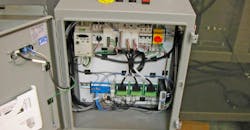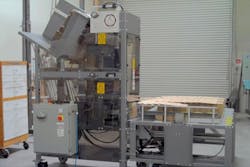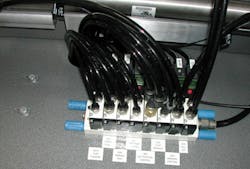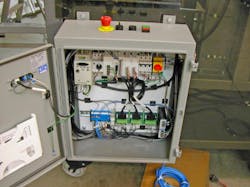Use PLCs for Simple Control of Pneumatic Machines
Even though Ridgeline Machine Design (RMD) was founded in 2012, our owners have more that 40 years’ experience designing and building custom machinery. We build packaging machinery for a variety of applications for product placement into cases or trays.
Some of the packaging equipment we design and manufacture includes wraparound side-, end-, and bottom-loading case packers in a wide variety of configurations. We also build case erectors, bag-in-box equipment, case sealers, and tray makers. Our equipment handles products housed in configurations such as chipboard trays and cartons, corrugated trays, plastic bottles, gable-top cartons, fiberboard caulking tubes, semi-rigid bags, and steel or plastic cans and tubs.
Engineering the Equipment
The packaging equipment typically handles from 10 to 50 cases/min., depending on the application, and we also offer a case sealer capable of speeds of to 114 cases/min. Our equipment typically has an open design for easy operation, quick adjustment, and simple maintenance. For example, one of our case erectors builds regular, slotted-case, and all-flaps-meet boxes with hot melt closure. It can be adjusted for a wide range of box sizes using just two handwheels. Another example is a case packer used where case sealing with pressure-sensitive tape is needed.
Our bottom-load case packer works well for applications where a traditional drop-case packer is a poor choice because fragile products could break during the loading cycle. Our machine provides a gentle bottom-up feature which results in greatly reduced shock to the product as it’s placed into the case. Depending on the application at hand, we’ll use pneumatic, servopneumatic, or servoelectric drives, each controlled by a PLC.
Putting Experience to Work
Our Model 25 automatic tray maker was developed in partnership with a manufacturer of custom door locksets and hardware. This particular machine assembles 18 trays per minute and takes up minimal floor space (Fig. 1).
1. The Model 25 tray maker from Ridgeline Machine Design was developed in partnership with a customer to make a compact, economical machine.
The customer needed to automate an operation that traditionally required their plant personnel to make the trays by hand. The production rate was only four trays per minute, and the new machine assembles trays at a rate of 18 per minute—a significant improvement. The automated machine also freed up four workers who can now perform other tasks to further improve production processes. The customer also wanted the machine to hold 50 finished trays on its output table.
Requirements from the customer included a small footprint, portability, low cost, easy operation, and simple maintenance. We knew we could use pneumatics in a creative design to meet all these requirements. Not only was pneumatics the motion control technology with the lowest initial cost, but over the life of the machine as well. It is simpler than electromechanical or electric servo solutions, is easy to understand and maintain, and is straightforward to control and troubleshoot.
Because the machine is portable, it operates from 120 V ac to simplify power connection and improve safety. Competing machines typically require 230/460 V ac and are more expensive. A small portable footprint is needed due to limited floor space and the need to move the tray maker to different locations. Low cost was another requirement, and one of the reasons we chose componentry from AutomationDirect.
The tray maker discharges each tray on its side to facilitate stacking (Fig. 2). Our older model tray maker had the tray blank move horizontally before setup, which required mechanical reorientation of much of the infeed assemblies.
2. Positioning completed trays on their side at the machine’s output makes it easy to stack them on top of other complete trays to conserve space.
New Machine Ready for Production
The Model 25 tray maker has is 7-ft high, 5-ft long, and 3-ft wide without the discharge table. The discharge table is 6-ft long by 4-ft wide. The tray maker is controlled with a wide variety of power distribution components, motors, drives, and safety relays and switches, all from AutomationDirect, which also provided an extensive pneumatic system starting from the main plant connection, proceeding to the flow controls, solenoids, tubing, fittings, and cylinders.
Much of this machine’s product-handling and assembly operations are pneumatic. The tray maker includes vacuum pick-off of tray blanks, which are positioned vertically to conserve space. Individual tray blanks are fed into the system using an ac-motor drive with a worm-gear speed reducer to drive the tray blank feed wheels.
The tray blanks are fed downward to the assembly and then set up by a pneumatic cylinder pressing the blank through tooling. The formed trays are then pneumatically offloaded to the discharge table.
Pneumatics for Assembly of Trays
The pneumatic components for the tray maker start with a 3/8-in. filter, regulator, and lubricator (FRL) feeding a bank of valves operating a mix of round, compact, and tie rod cylinders. The FRL includes an electric dump valve to relieve the air supplied to the control valves when a door is opened or an emergency stop is pressed. A manual lockable valve on the inlet provides the required lockout/tagout functionality when the equipment is serviced.
Air valves (Fig. 3) control all cylinder and vacuum generator operation. The valves are sized for worst-case flow for any function on the tray maker. In this case, 4-way valves were specified to control all the cylinders because their flow coefficient (CV) of 0.89 is sufficient for the cylinders to operate and maintain proper speed. A 3-way valve was selected to operate the pneumatic vacuum generator for the same reason.
3. Manifold-mounted air valves conserve space over their line-mounted counterparts and allow placing them near the cylinders they control for quick response. Exhaust silencers mounted at both ends of the manifold keep operation quiet.
We prefer to use manifolds to feed air to the pneumatic control valves, and we specified an 8-station unit on this machine for that purpose. We specified ½-in. tubing to ensure high flow capacity in supplying compressed air to the valve manifolds. Plastic silencers on both ends of the manifold reduce noise and ensure minimal restriction of exhaust air.
The valves were wired using solenoid cables which include built-in surge suppression and an LED to show when power is present to the solenoid. Surge suppression improves the life of the PLC outputs by eliminating voltage spikes, and the LED indicator clearly shows valve status which simplifies and speeds maintenance.
Details on the Air Cylinders
We specified three different pneumatic cylinder configurations based on space constraints and required motion. If the cylinder produces rotational motion, either by moving a lever or pushing a rack to turn a gear, we specified tie rod cylinders with built-in cushions. For other low-power or supplemental motion, we specified either round-body (Fig. 4) or compact cylinders.
4. The Model 25 makes liberal use of round-body cylinders because of their small size, which is essential for a compact machine.
Except for the vertical tray blank feed wheel motion, which is electromechanical, pneumatic cylinders provide all the motion required to feed, assemble, and stack the trays. All cylinders critical to the assembly/setup of the tray include magnetoresistive sensors along with magnetic pistons in the cylinders. The sensors provide error-proofing of cylinder end-of-stroke motion for each step of the machine assembly sequence.
The Programmable Logic Controller
The tray maker is controlled by a Model C0-00DR PLC from AutomationDirect, which has an expansion I/O and terminal blocks for field wiring. A bulkhead programming port with its outlet on the control enclosure door simplifies compliance with arc flash regulations by allowing changes to be made to the controller software without opening the door (Fig 5).
5. A Model C0-00DR PLC from AutomationDirect has bulkhead programming port outlet on the control’s enclosure door to allow revising software without opening the enclosure door.
AutomationDirect also provided the power distribution hardware including a non-fused disconnect switch, branch circuit protection circuit breakers, and a rotary motor protector switch to disconnect power from the motor drive.
Operator control buttons include a selector switch, pushbuttons and an E-stop mushroom pushbutton. Background-suppression photosensors and cylinder position sensors detect the presence or absence of product.
The end result is that you can build a machine that combines the reliable operation of pneumatics with the flexibility of a PLC that is simple to operate and maintain without breaking the bank.
Todd Dice was general manager at Ridgeline Machine Design LLC, Ontario, Calif. when this discussion was written.
About the Author

Leaders relevant to this article:






